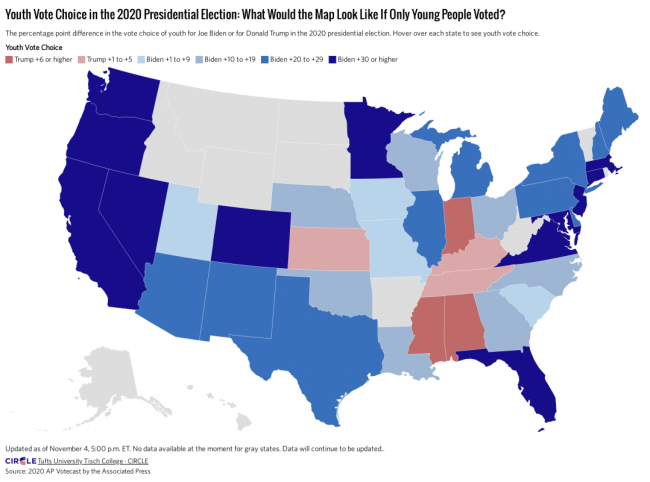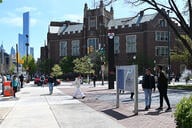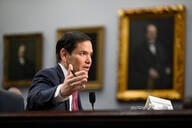You have /5 articles left.
Sign up for a free account or log in.

Center for Information and Research on Civic Learning and Engagement (CIRCLE) at Tufts University
Voters under age 30 leaned heavily Democratic, favoring Joe Biden over President Donald Trump by a wide margin (61 versus 36 percent) in the still-to-be-decided presidential election, but there were key differences among young voters across gender, racial and state lines, according to an analysis of exit polling data from the Center for Information and Research on Civic Learning and Engagement (CIRCLE) at Tufts University in Massachusetts
In estimates that were revised Wednesday, CIRCLE's analysis found that young white men supported Trump by a six-point margin (51 versus 45 percent), while young white women favored former vice president Biden by 13 percentage points (55 to 42 percent).
Young voters of color favored Biden by larger margins than did young white voters. Young Black, Asian and Latino voters supported Biden by margins of 76, 69 and 51 points, respectively.
In Georgia and North Carolina, 90 percent or more of young Black voters chose Biden, while more than half of young white voters (54 percent in North Carolina and 63 percent in Georgia) favored Trump.
In Texas, Latinx voters supported Biden over Trump by a nearly 50-percentage-point margin (73 versus 25 percent), while a majority of young white voters preferred Trump (51 versus 45 percent for Biden).
CIRCLE does not have data on the estimated percentage of 18- to 29-year-old voters who are enrolled in college or have college degrees. In 2016, education levels were decisive in predicting who would vote for Trump, with the president racking up strong support among Americans without college degrees.
"In some ways, it shows how fractured young people have become in terms of polarization," Kei Kawashima-Ginsberg, CIRCLE's director, said of the findings about different youth voter preferences by gender and race. She noted for example that racism and climate change are among the top issues cited by young voters.
"You would think if they care deeply about climate change and racism, their presidential choice might be driven by the issue," she said. "But it’s not panning out for the young white men. A majority seems to have chosen President Trump."
Over all, young voters chose Biden at higher rates than did individuals of any other age group. Young people voted for Biden over Trump at higher rates in 33 of the 39 states for which CIRCLE had data on Tuesday. A map of what the presidential map would look like if only young people had voted can be seen above: in such a scenario, all the major battleground states, plus Texas, would be blue, while only the heavily Republican states of Alabama, Indiana, Kansas, Kentucky, Mississippi and Tennessee would be red.
CIRCLE estimates that voters under 30 supported Biden by significant margins in some battleground states. Young voters appear to be on track for casting more votes than the total margin of victory in some key battleground states.
| Youth Share of Total Vote | Biden's Advantage in Youth Vote | |
| Arizona | 17% | +28% |
| Georgia | 21% | +15% |
| Michigan | 15% | +29% |
| North Carolina | 16% | +16% |
| Pennsylvania | 14% | +23% |
| Wisconsin | 14% | +27% |
In Wisconsin, where Biden is projected to have won by about 20,000 votes, young people cast an estimated 281,000 votes for Biden and 157,000 for Trump. In North Carolina, where Trump is leading by almost 77,000 votes but a victor has not yet been declared, Biden's 16-point advantage among young voters translates into a 140,000-vote advantage in youth votes.
CIRCLE estimates that nearly half of eligible young people -- 47 to 49 percent -- turned out to vote in the U.S. presidential election in 11 mostly battleground states: Arizona, Colorado, Florida, Georgia, Iowa, Montana, North Carolina, Ohio, South Carolina, Texas and Wisconsin.
"If votes continue coming in at the same rate in each state, youth voter turnout across these states could rise to 51 percent to 53 percent," CIRCLE says in a press release. "For comparison, using the same sources and methodology, we estimate that youth turnout nationally was 42-44 percent in 2016 at this same moment."
Turnout tends to be higher in the battleground states, and Kawashima-Ginsberg said it is too early to say whether youth voter turnout will be higher nationally this year compared to 2016.
"On the one hand, young people were really civically engaged, but there were so many barriers to voting," she said. She noted voter registration levels for 18- and 19-year-olds were below what she'd expect to see in a high-turnout year, which she attributed in part to the fact that many colleges and high schools are teaching remotely because of the coronavirus pandemic.
In the months leading to the election, advocates for youth voting worried about the confusion over changes to voter laws and efforts aimed at suppressing the Democratic-leaning youth vote.
CIRCLE estimates that voters under age 30 made up an estimated 17 percent of all voters in the U.S. presidential election, slightly more than their 16 percent share in the presidential election of 2016. Of the states for which data are available, Georgia had the highest share of youth vote (21 percent) and Kentucky the lowest (10 percent).




